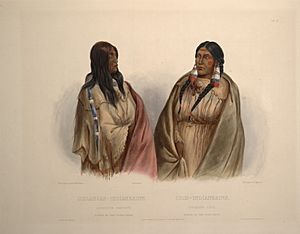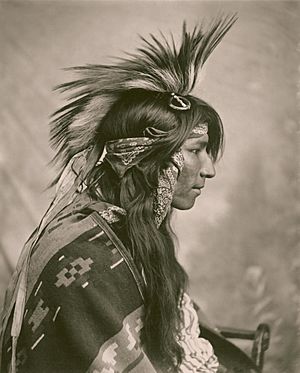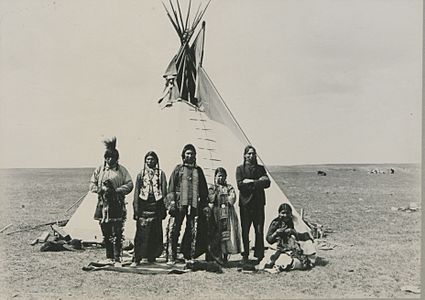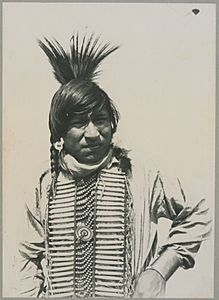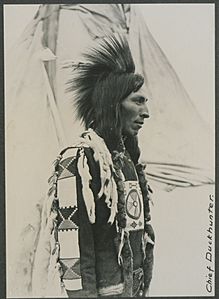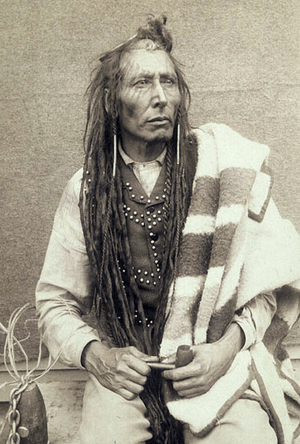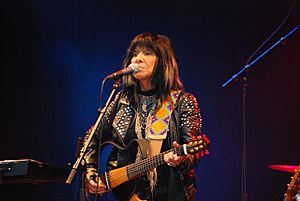Cree facts for kids
| Néhinaw, Néhiyaw, etc. | |
|---|---|

Two Cree boys, near Chisasibi, Quebec
|
|
| Total population | |
| 392,420 (2016 census) Including Atikamekw and Innu |
|
| Regions with significant populations | |
| Canada, United States | |
| Alberta | 95,300 |
| Saskatchewan | 89,990 |
| Manitoba | 66,895 |
| Quebec | 58,640 |
| Ontario | 36,750 |
| British Columbia | 35,885 |
| Montana | 3,323 |
| Newfoundland and Labrador | 3,255 |
| Northwest Territories | 2,195 |
| Nova Scotia | 1,780 |
| Languages | |
| Cree, Cree Sign Language, English, French | |
| Religion | |
| Anglicanism, Pentecostalism, Roman Catholicism | |
| Related ethnic groups | |
| Métis, Oji-Cree, Ojibwe, Innu | |
The Cree (Cree: Néhinaw, Néhiyaw, etc; French: Cri) are one of the largest groups of First Nations in North America.
In Canada, over 350,000 people are Cree or have Cree family roots. Most Cree in Canada live north and west of Lake Superior. These areas include Ontario, Manitoba, Saskatchewan, Alberta, and the Northwest Territories. About 27,000 Cree live in Quebec.
In the United States, Cree people historically lived from Lake Superior westward. Today, most live in Montana. They share the Rocky Boy Indian Reservation with Ojibwe (Chippewa) people.
The Cree moved westward over time. This was strongly linked to their roles as traders and hunters in the North American fur trade.
Contents
- When Did Cree People First Meet Europeans?
- What Are the Main Cree Groups and Where Do They Live?
- How Were Cree Communities Organized?
- What Does the Name "Cree" Mean?
- What About the Cree Language?
- Who Are the Cree in Canada and the United States?
- Where Are Cree First Nation Communities Located?
- Who Are Some Important Cree Leaders?
- Who Are Some Other Famous Cree People?
- See Also
When Did Cree People First Meet Europeans?
Europeans first met the Cree in 1682. This happened at the mouth of the Nelson and Hayes rivers in northern Manitoba. A group from the Hudson's Bay Company (HBC) traveled inland to meet them. Contact in the south happened later.
In 1732, in what is now northwestern Ontario, Pierre Gaultier de Varennes, sieur de La Vérendrye, met 200 Cree warriors. They were near present-day Fort Frances. They also met the Monsoni, a branch of the Ojibwe. Both groups were ready for a conflict with the Dakota and another Ojibwe group.
After getting firearms from the HBC, the Cree became traders. They moved into the plains and acted as middlemen with the HBC.
What Are the Main Cree Groups and Where Do They Live?
The Cree are generally divided into eight groups. These groups are based on their dialect and where they live. These divisions do not always mean they are different ethnic groups.
- The Naskapi and Montagnais (together known as the Innu) live in an area called Nitassinan. This land covers most of eastern Quebec and Labrador. Their cultures are a bit different. Some Naskapi still hunt caribou and move around more. The Montagnais have more settled communities. In 2003, about 18,000 people belonged to these two groups. About 15,000 lived in Quebec. Their dialects are very different from the Cree spoken west of Lake Superior.
- Atikamekw people live in an area they call Nitaskinan (Our Land). This is in the upper St. Maurice River valley of Quebec. Their population is around 4,500.
- East Cree – This group includes about 18,000 Cree. They live in the Eeyou Istchee and Nunavik regions of Northern Quebec.
- Moose Cree – This group lives in Moose Factory, Ontario. They are on Moose Factory Island, near the mouth of the Moose River. "Factory" used to mean a trading post.
- Swampy Cree – This group lives in northern Manitoba along the Hudson Bay coast. They also live in Ontario along the Hudson Bay and James Bay coasts. Some also live in eastern Saskatchewan. About 4,500 people speak this dialect.
- Woods Cree – This group lives in northern Alberta and Saskatchewan.
- Plains Cree – There are 34,000 Plains Cree people. They live in Manitoba, Saskatchewan, Alberta, and Montana.
The many dialects of the Cree language mean the people do not have one modern name for themselves. Plains Cree and Attikamekw call themselves nêhiyaw and nêhirawisiw. Moose Cree, East Cree, Naskapi, and Montagnais use forms of iriniw, meaning 'man'. The Cree use "Cree," "cri," "Naskapi," or "montagnais" when speaking French or English.

How Were Cree Communities Organized?
Historical Organization

Cree people were hunter-gatherers. Their smallest group was the lodge, with about 8 to 12 people. These were usually two related families living in a wigwam or tipi. Several lodges formed a band, which moved and hunted together.
If there was a disagreement, lodges could leave a band. Bands could also form and break up easily. But being part of a band offered safety. Being sent away from a band was a very serious punishment. Bands often had strong ties with neighbors through marriage. They would gather at different times of the year to hunt and socialize.
Beyond these regional gatherings, there was no higher formal structure. Decisions about conflicts were made by talking together with allied bands. People were also identified by their clan. A clan is a group of people who believe they share a common ancestor. Each clan had a representative and a vote in important band meetings.
Each band was independent. However, Cree-speaking bands often worked together. They also worked with their neighbors against outside enemies. The Cree who moved to the Great Plains and hunted bison were called the Plains Cree. They allied with the Assiniboine and the Saulteaux. This alliance was known as the "Iron Confederacy". It was very powerful in the North American fur trade from the 1730s to the 1870s. The Cree and Assiniboine were important traders in the northern plains.
When a band went to war, they chose a temporary military leader. This leader was called an okimahkan, or "war chief". This role was different from a "peace chief," who was more like a diplomat. For example, during the 1885 North-West Rebellion, Big Bear was his band's leader. But when fighting started, Wandering Spirit became the war leader.
Modern Organization
There have been several efforts to create a national group to represent all Cree peoples. One such gathering happened in 1994 at the Opaskwayak Cree First Nation reserve.
What Does the Name "Cree" Mean?
The name "Cree" comes from an Algonkian word, Kirištino˙. The Ojibwa used this word for tribes around Hudson Bay. French colonists and explorers spelled it in different ways, like Kilistinon or Cristinaux. They used this term for many tribes they met north of Lake Superior, in Manitoba, and further west. The French used these terms for various groups in Canada. Some of these groups are now known as Severn Anishinaabe (Ojibwa), who speak different dialects from Algonquin.
Depending on their community, Cree people might call themselves by other names. These include nēhiyawak, nīhithaw, nēhilaw, and nēhinaw. Or they might use ininiw, ililiw, iynu (innu), or iyyu. These names come from older words meaning "person" or of uncertain meaning. Cree people using the latter names usually live in Quebec and Labrador.
What About the Cree Language?
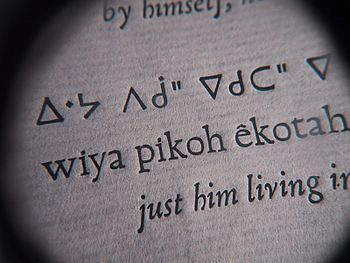
The Cree language is a group of related Algonquian languages. About 117,000 people speak it across Canada. It is spoken from the Northwest Territories to Labrador. It is the most widely spoken Indigenous language in Canada. The only place where Cree has official status is in the Northwest Territories. There, it is official along with eight other Indigenous languages.
The two main groups, Nehiyaw and Innu, speak dialects that are mostly understandable to each other. However, a Plains Cree speaker from Alberta might find it hard to understand a Quebec Cree speaker without practice. It's more like a chain of dialects.
Cree is one of 55 languages with over 1,000 speakers that children are still actively learning.
Who Are the Cree in Canada and the United States?
In Canada
The Cree are the largest group of First Nations in Canada. They have 220,000 members and 135 registered bands. Their reserve lands are the largest of any First Nations group in the country. The biggest Cree band is the Lac La Ronge First Nation in northern Saskatchewan. It is also the second largest First Nations Band in Canada.
Historically, Cree bands often had people of mixed heritage. Speaking multiple languages and having different cultures was common. In the West, bands often included Cree, Saulteaux, and Assiniboine people. These groups were all partners in the Iron Confederacy. However, in recent years, Indigenous languages have declined. This has led to a simpler identity for some bands. Many bands in Saskatchewan now identify as "Plains Cree." This is partly because of the popularity of Plains Indian culture. Also, Plains Cree has more written rules and is seen as more important than other Cree dialects.
The Métis are people of mixed ancestry. This often means they have both Indigenous (like Nehiyaw or Anishinaabe) and European (like French, English, or Scottish) heritage. Historically, Métis were often the children of French fur traders and Nehiyaw women. Or they were from unions of English or Scottish traders and northern Dene women. Today, the Métis National Council defines a Métis as "a person who self-identifies as Métis, is distinct from other Aboriginal peoples, is of historic Métis Nation Ancestry and who is accepted by the Métis Nation."
-
Group of Cree people.
-
Merasty women and girls, Cree, The Pas, Manitoba, 1942.
-
Chief King of the Wind.
-
Chief Thundercloud.
-
Chief Duckhunter.
In the United States
The Cree once lived in northern Minnesota, North Dakota, and Montana. Today, American Cree are part of the federally recognized Chippewa Cree tribe. This tribe is located on the Rocky Boy Indian Reservation. They share this reservation with the Pembina Band of Chippewa Indians. Other Cree live as "Landless Cree" on the Fort Peck Indian Reservation and the Fort Belknap Indian Reservation. On these reservations, the Cree share the land with the Assiniboine, Gros Ventre, and Sioux tribes. The traditional southern border of Cree land in Montana was the Missouri River and the Milk River.
Where Are Cree First Nation Communities Located?
|
1 Naskapi (Iyiyiw and Innu) 2 Montagnais b Western Montagnais (Nehilaw and Ilniw) 3 Atikamekw (Nehiraw) 4 James Bay Cree
5 Moose Cree (Mōsonī / ililī)
6 Swampy Cree (Maškēkowak / nēhinawak)
7 Woodland Cree
|
b Woods Cree (Sakāwithiniwak / nīhithawak)
8 Plains Cree (Paskwāwiyiniwak / nēhiyawak)
i Calling River / Qu'Appelle Cree (Kātēpwēwi-sīpīwiyiniwak)
ii Rabbit skins (Wāpošwayānak)
iii Touchwood Hills Cree (Pasākanacīwiyiniwak)(also Saulteaux) – Punnichy, Saskatchewan
iv Cree-Assiniboine / Young Dogs (Nēhiyawi-pwātak)(also Assiniboine)
b Upstream People (Natimiyininiwak)
i Beaver Hills Cree (Amiskwacīwiyiniwak)
ii House Cree (wāskahikaniwiyiniwak)
iii Parklands Cree / Willow Cree (Paskokopāwiyiniwak)
iv River Cree (Sīpīwininiwak)
v Northern Plains Cree / Western Woodland Cree / Bush Cree (Sakāwiyiniwak)
|
Who Are Some Important Cree Leaders?
Here are some notable Cree leaders:
- Ahchuchhwahauhhatohapit (Acahkosa kā-otakohpit, "Starblanket") was a Chief of the Calling River Cree. He was born around 1845. He settled on a reserve in Saskatchewan after the bison disappeared.
- Payipwāt (or Piapot, "One who Knows the Secrets of the Sioux") was a powerful Chief of the Cree-Assiniboine. He was born in 1816 and was a significant Shaman. He tried to create a large Indigenous territory.
- Kee-a-kee-ka-sa-coo-way ("The Man Who gives the War Whoop") was a leading Chief of the Plains Cree in the mid-19th century.
- Mistahi-maskwa (better known as Big Bear) was a Chief of the Plains Cree. Born around 1825, he resisted the idea of dividing the Cree into many small reservations.
- Mistāwasis ("Big Child") was a Chief of the Parklands/Willow Cree. Born around 1813, he helped convince the Cree to accept Treaty 6. He was respected by other nations, including the Siksika.
- Kapapamahchakwew (better known as Wandering Spirit) was a war chief under Mistahimaskwa. He was involved in the 1885 North-West Rebellion.
- Kamiokisihkwew (Fine Day) was a Chief of the Plains Cree. He was a shaman and war chief. He led an uprising during the North-West Rebellion.
- Pitikwahanapiwiyin ("Poundmaker") was a Chief of the River Cree. Born around 1842, he was involved in the negotiations for Treaty 6 in 1876.
- Wīhkasko-kisēyin (better known as Chief Sweet Grass) was a leader of the Plains Cree. He signed Treaty 6 in 1876.
- Peechee (Pisiw - "Mountain Lion") was a Chief of the Rocky/Mountain Cree. Born around 1821, his sons were also important leaders.
- Ermineskin ("One with skin like an ermine") was a Chief of the Bear Hills Cree. He was the son of Pesew.
- Keskayiwew (Bobtail) was a Chief of the Bear Hills Cree. He became chief after his older brother's death.
- Kamdyistowesit ("Beardy") was a Chief of the Parklands or Willow Cree. He became a leader in the 1870s.
- Küpeyakwüskonam (One Arrow) was a Chief of the Parklands or Willow Cree. He signed Treaty 6 in 1876.
- Minahikosis (Little Pine) was a Chief of the Plains Cree. Born around 1830, he led resistance against Blackfoot Confederacy. He signed Treaty 6 in 1879.
- Papewes ("Lucky Man") was a Chief of the Plains River Cree. He signed an annex to Treaty 6 in 1879.
- Saswaypew ("Cut Nose") was a Chief of the Parklands or Willow Cree. He was related by marriage to One Arrow and Beardy.
- Maskepetoon ("Broken Arm", later called Peacemaker) was a Chief of a Rocky/Mountain Cree group. He was known for his bravery and later worked for peace.
- Pihew-kamihkosit (better known as Red Pheasant) was a Chief of the Plains River Cree. He signed Treaty 6 in 1876.
- Peayasis (better known as François Desjarlais) was a Chief of the Beaver River Cree. He signed Treaty 6 in 1876.
- Kahkewistahaw was a Chief of the Rabbit Skin Cree and Saulteaux. He signed Treaty 4 in 1874.
- Paskwüw (Pasquah - "The Plain") was a Chief of the Plains Cree. He participated in negotiations for Treaty 4 in 1874.
- Petequakey ("Comes to Us With the Sound of Wings") was a Chief of the Parklands or Willow Cree at Muskeg Lake. He participated in the battle at Duck Lake in 1885.
- Kee-too-way-how ("Sounding With Flying Wings") was a Chief of the Parklands or Willow Cree at Muskeg Lake. He played a role in the Northwest Rebellion of 1885.
Who Are Some Other Famous Cree People?
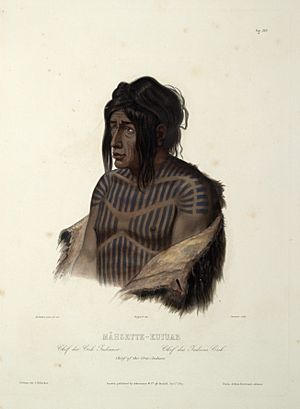
- Janice Acoose, author
- Nathaniel Arcand, actor
- Irene Bedard, actress
- Ashley Callingbull-Burnham, 2015 Mrs. Universe winner, actress, and Indigenous activist
- Mary Katherine Campbell, former Miss America
- Harold Cardinal, writer, political leader, teacher, and lawyer
- Lorne Cardinal, actor
- Tantoo Cardinal, actor
- Jonathan Cheechoo, NHL and KHL hockey player
- Billy Diamond, political leader and first Grand Chief of the Grand Council of the Crees
- Neil Diamond, filmmaker
- Angela DeMontigny, fashion designer
- Michael Eklund, actor
- Connie Fife, poet
- Theoren Fleury, retired NHL hockey player and humanitarian
- Ralph Garvin Steinhauer, former Lieutenant Governor of Alberta
- Edward Gamblin, musician
- Mary Greyeyes, first First Nations woman to join the Canadian Armed Forces
- Michael Greyeyes, actor
- Tomson Highway, playwright
- Tyson Houseman, actor
- Cody Lightning, actor
- Ovide Mercredi, National chief of the Assembly of First Nations
- Delia Opekokew, lawyer and activist
- Bronson Pelletier, actor
- Romeo Saganash, Member of Parliament for Abitibi—Baie-James—Nunavik—Eeyou, Quebec
- Buffy Sainte-Marie, singer
- Paul Seesequasis, writer and journalist
- Cree Summer, singer/actress
- Roseanne Supernault, actress
- Richard Throssel, photographer
- Michelle Thrush, actor
- Gordon Tootoosis, actor
- Shane Yellowbird, Country singer
- Alfred Young Man, educator, writer, curator, artist
|
See Also
 In Spanish: Cree para niños
In Spanish: Cree para niños


